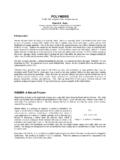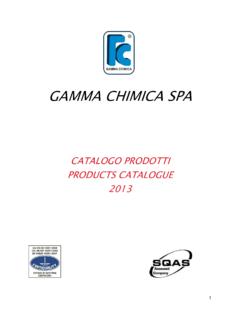Transcription of A Crystal Lab - VDOE
1 Science Enhanced Scope and Sequence Chemistry virginia department of education 2012 1 A Crystal Lab Strand Nomenclature, Chemical Formulas, and Reactions Topic Investigating bonding, nomenclature, and formula writing Primary SOL The student will investigate and understand how conservation of energy and matter is expressed in chemical formulas and balanced equations. Key concepts include d) bonding types. Related SOL The student will investigate and understand that experiments in which variables are measured, analyzed, and evaluated produce observations and verifiable data. Key concepts include a) designated laboratory techniques; b) safe use of chemicals and equipment; c) proper response to emergency situations.
2 Background Information Copper sulfate pentahydrate will grow beautiful blue rhombic crystals. The quality of the crystals greatly depends on the quality of the copper sulfate compound used. If you have crystalline reagent grade cupric sulfate, you will get first-rate crystals. Try to avoid using powered copper sulfate, as it does not produce very good results. Students can get great results using copper sulfate purchased from hardware or lawn-care stores. Students can change the rate at which the solution evaporates by covering it or leaving it uncovered in order to see how this affects the size of the crystals. Potassium aluminum sulfate (alum) will grow clear hexagonal crystals, and sodium chloride will grow clear cubic crystals.
3 Potassium aluminum sulfate can be purchased at the grocery store. The silver crystals are really beautiful and are amazing to watch under the stereoscope because they look like shiny silver trees. The following background information is essential to the understanding of this activity: The behavior of substances in the solid state is governed mainly by the way in which the atoms, ions, or molecules of the substance are arranged and the forces that hold them together. These experiments deal only with ionic and metallic crystalline solids. Each of these is distinguished by the kinds of particles that make up the three-dimensional structure of the solid.
4 If the structure has a regular pattern, then the solid is described as crystalline. A familiar example would be sodium chloride (NaCl), in which sodium ions and chloride ions alternate in an extended structure known as a Crystal lattice. In this structure, each ion occupies a point in space called a lattice point. This is an example of an ionic crystalline solid since ions are the structural unit. Any crystalline solid would exhibit a similar orderly arrangement of particles. Some solids, however, do not have such organization on the molecular level. Substances such as glass are really super-cooled liquids or amorphous solids Science Enhanced Scope and Sequence Chemistry virginia department of education 2012 2 because they lack a definite Crystal -lattice organization.
5 In this experiment, we are concerned only with crystalline solids. Ionic crystals are, of course, composed of ions. These are held tightly in place in the Crystal lattice by strong electrostatic forces because of the opposite charges of the ions. These very strong forces contribute to high melting points. Although the ions are charged, they cannot move in the solid; hence, these crystals in their solid form do not conduct electricity. However, when melted, most of the attractions in the lattice structure have been overcome, and molten ionic compounds conduct electricity very well since the charged ions are now free to move.
6 Many ionic compounds also dissolve in water. The amount that dissolves is completely separated into ions and thus makes a solution which is a good conductor of electricity. Ionic crystals get larger by adding layers of ions on the outside of the base structure. Sometimes a seed Crystal is added to form this base. Crystals can be grown from a solution of a substance dissolved in a liquid; when the liquid evaporates, the dissolved substance joins together in a Crystal structure. The more slowly the liquid cools and evaporates, the larger and more pure the Crystal structure will be. Metallic crystals consist of metal cations positioned at the lattice points of the Crystal .
7 The valence electrons are given up to a common sea of electrons that flows freely throughout the metal cations. This property in metallic bonding makes most metals malleable. Metals are excellent conductors of electricity because of all the mobile electrons. This conductivity exists in both the solid and liquid state. Supersaturated solutions are highly unstable solutions in which a saturated solution has been forced to hold more of a dissolved substance than it should be able to hold at that temperature. Supersaturated solutions are formed by quickly and carefully cooling saturated solutions. The crystals will not form unless the solution is jarred or a seed Crystal is introduced.
8 Once the crystallization process starts, it continues rapidly until all of the solution is crystallized. The test tube should feel warm during the crystallization process. Crystallization is an exothermic process that gives off heat energy. When bonds form, energy is released in the form of heat. The Crystal -lattice structure is more stable and lower in energy than the solution, so by forming the Crystal lattice, the compound increases its stability and decreases its potential energy. Sodium thiosulfate is a hydrated compound that contains water molecules bonded to the lattice structure. When heated, the water molecules are removed, and the remaining substance dissolves in the water.
9 This makes it easy to make a supersaturated solution of sodium thiosulfate. Materials Distilled water Beaker Burner Filter paper Safety goggles Watch glasses Science Enhanced Scope and Sequence Chemistry virginia department of education 2012 3 Stereoscope Sodium chloride (NaCl) Copper(II) sulfate pentahydrate (CuSO4 5 H2O) Potassium aluminum sulfate [KAl(SO4)2] Copper wire Aluminum wire M silver nitrate (AgNO3) solution M copper(II) nitrate [Cu(NO3)2] solution Sodium thiosulfate (Na2S2O3 5 H2O) crystals Test tube Utility clamp Cold running water Window facing bright sunshine or other good light source Vocabulary anion, cation, compound, crystals, evaporation, ionic, lattice points, metallic, particle, pattern, saturated, seed Crystal , solution, stereoscope, supersaturated Student/Teacher Actions (what students and teachers should be doing to facilitate learning) Introduction 1.
10 Explain to students that they will be dealing with only ionic and metallic crystalline substances in this experiment. Each of these is distinguished by the kinds of particles that make up the three-dimensional structure of the solid. If the structure has a regular pattern, then the solid is described as crystalline. Ionic crystals are, of course, composed of both cations and anions. Metallic crystals consist of only metal cations positioned at the lattice points of the Crystal . Procedure Experiment 1: Ionic Crystal Formation 1. Place approximately 50 mL of distilled water in a clean beaker, and begin heating. Be sure to keep the water below boiling temperature.
















